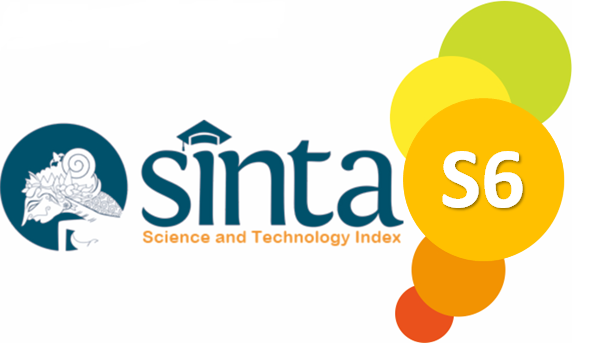Pengembangan Model Penerimaan Teknologi
Kasus Electronic Ticketing TIX ID
DOI:
https://doi.org/10.33557/jtekno.v18i1.1163Keywords:
SEM; AMOS; TAM; Electronic TicketingAbstract
The world is developing exponentially and rapid. Industrial 4.0 is a milestone of industrial digitalization. Hence, the change of B2C business interaction with consumer. Annual growth of internet and smartphone users force industries such as creative industries to develop mobile application, This industry contributes 7.44% to national GDP in 2018 and is projected to be bigger each year. The growth of theatre count in Indonesia triggers film industries as part of creative industries to grow. TIX ID as an electronic ticketing keen on serving the best service quality to consumer through online purchases. From this phenomenon, researcher decided to identify the factors that will affect the adoption of TIX ID. This research employs an extended TAM which are Self-Efficacy and Subjective Norm. Questionnaires were distributed and a sample of 647 respondents was taken for analysis using SEM with AMOS. Findings of this study reveal that Self-Efficacy affects Perceived Ease of Use and Perceived Usefulness. Perceived Ease of Use affects Perceived Usefulness but doesn’t affect Attitude. Perceived Usefulness affects attitude and behaviour intention. Attitude and Subjective Norm affects behaviour intention.
References
[2] Sukwadi, R., & Gammadita, M.C. (2016). Analisis retensi pengunjung bioskop di Jakarta menggunakan regresi logistik multinomial, Jurnal Teknologi, 9(2), 89-97.
[3] Sukwadi, R., Inderawati, M.M.W., & Indah, M.Y. (2016). Perilaku konsumen dalam pemilihan online shop Instagram, Jurnal Metris, 17(2), 123-132.
[4] Sukwadi, R., Lasiman, S.C., Inderawati, M.M.W., & Suprata, F. (2019). Niche theory within video platform competition: traditional vs. modern. IOP Conference Series: Materials Science and Engineering, 567(1),012003.
[5] Wang, C., Lo, S., & Fang, W. (2008). Extending the technology acceptance model to mobile telecommunication innovation: The existence of network externalities. Journal of Consumer Behaviour, 7(2), 101–110.
[6] Boyer, K., Hallowell, R., & Roth, A. (2002). E-services: Operating strategy—A case study and a method for analyzing operational benefits. Journal of Operations Management, 20, 175-188.
[7] Sulaiman, A., Ng, J., & Mohezar, S. (2008). E-ticketing as a new way of buying tickets: Malaysian perceptions. Journal of Social Science, 17(2),149-157.
[8] Pavlou, P. (2003). Consumer acceptance of electronic commerce: integrating trust and risk with the Technology Acceptance Model. International Journal of Electronic Commerce, 7(3), 101–135.
[9] Sreejesh, S., Mohapatra, S., & Anusree, M. (2014). Business Research Methods. USA: Springer.
[10] Databoks. (2020). Inilah Proyeksi Jumlah Penduduk Indonesia 2020. Retrieved 8 Agustus 2020, https://databoks.katadata.co.id/datapublish/2020/01/02/inilah-proyeksijumlah-penduduk-indonesia
[11] Hasibuan, L. (2018). Terungkap! Pria Senang Cashback, Wanita Suka Diskon. Retrieved July 30, 2019, from CNBC Indonesia: https://www.cnbcindonesia.com/lifestyle/20181017125649-33- 37747/terungkap=pria-senang-cashback-wanita-suka-diskon.
[12] Kasasa. (2020). Boomers, Gen X, Gen Y, Gen Z Explained. Retrieved 8 Agustus 2020, from KASASA: https://www.kasasa.com/articles/generations/gen-xgen-y-gen-z
[13] Kinescope. (2015). Bioskop di Indonesia: Quo Vadis Perfilman Nasional. Retrieved 8 Agustus 2020, from Kinescope: https://kinescopemagz.com/bioskop-diindonesia-quo-vadis-perfilman-nasional/
[14] Finansialku. (2014). Siapa Saja Kelas Menengah Indonesia? Retrieved 5 Agustus 2020, from Finansialku.com: https://www.finansialku.com/siapa-sajakelasmenegah-indonesia/amp/
[15] Santoso, S. (2011). SEM: Konsep dan Aplikasi dengan AMOS 18. PT. Elex Media Komputindo, Jakarta.
[16] Ghozali, I. (2005). Model Persamaan Struktural. Semarang: Badan Penerbit Universitas Diponegoro.
[17] Vandenberg, R. J. (2006). Statistical and methodological myths and urban legends. Organizational Research Methods, 9(2), 194-201.
[18] Zainudin, A. (2014). A Handbook on SEM. Malaysia: MPWS Publisher.
[19] Escobar, M.D., & West, M. (1995). Bayesian density estimation and inference using mixtures. Journal of the American Statistical Association, 90, 577–588.
[20] Kline, R. (2010). Principles and Practice af Structural Equation Modeling. UK, Guilford Press.
[21] Bryne, B. (2016). Structural Equation Modelling With AMOS. Kanada: Routledge.
[22] Savalei, V., & Kolenikov, S. (2008). Constrained versus unconstrained estimation in structural equation modeling. Psychological Methods, 13(2),150–170.
[23] Gao, S., Mokhtarian, L., & Johnston, R. (2008). Nonnormality of data in structural equation models: transportation research record. Journal of the Transportation Research Board, 2082(1), 116–124.
Downloads
Published
Issue
Section
License

Jurnal Tekno by journal.binadarma.ac.id/index.php/jurnaltekno is licensed under a Creative Commons Attribution-ShareAlike 4.0 International License.









